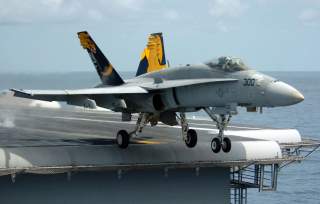This Upgrade Will Make the Super Hornet Deadlier Than Ever
The SM-6 offers many possibilities.
In the Navy’s recent budget request, the Navy finally funded the design an acquisition of conformal fuel tanks for the Super Hornet. With the potential to extend the range of the Hornet with a low drag external fuel tank, the tanks can either expand the range of a Super Hornet or free up two high capacity weapons stations by replacing the two external tanks currently used on almost every flight. One option would help to restore a long-range interception role that has been missing from the Navy since the retirement of the Tomcat in the 2000s. With four capacity weapons stations available on the Super Hornet, the SM-6 Dual I SAM could be modified to serve as a long-range air to air missile, much like the Standard SM-1 was modified to serve as an anti-radiation during the Vietnam War.
Since the retirement of the Tomcat from carrier decks in 2006, the Navy has lacked an interceptor with the ability to engage targets capable of carrying long-range cruise missiles. With the death of the Soviet Naval Bomber Force at the end of the Cold War, there has not been a country capable of operating more than a handful of cruise missile carrying bombers. In the past few years, the threat scope has changed dramatically, as Soviet operations have expanded, and the Chinese bomber force has been modernized with the introduction of the Badger H-6K. The Navy does not have an interceptor capable of shooting the archer before he shoots his arrows. A Super Hornet with three external fuel tanks and a full air intercept load of 6 AIM-120D has rather limited effective combat radius of around 400 miles. As a result, the maximum engagement range of the Super Hornet/AIM-120D combination less than Tomcat/Phoenix combination from the 1990s.
Recommended: America Has Military Options for North Korea (but They're All Bad)
Recommended: 1,700 Planes Ready for War: Everything You Need To Know About China's Air Force
Recommended: Stealth vs. North Korea’s Air Defenses: Who Wins?
The Navy currently has two products in development that can address this new long-range cruise missile threat: The Block III Super Hornet with conformal fuel tanks and the SM-6 Dual II missile. The Block III Super Hornet in development will include conformal fuel tanks that will allow the Block III Hornet to have an increased combat radius while freeing up the high capacity weapons stations 4 and 8. A Block III Hornet with the conformal fuel tanks will be able to carry 4 SM-6 Dual II missiles and 6 AIM-120D missiles along with a single external fuel tank on weapons station 6 to a combat radius of 510 miles.
The SM-6 Dual II missile currently in development by the Navy is capable of engaging both air and surface targets out to a range of 130 miles when launched from the surface. The missile is about 15 feet in length and 1,800 pounds, and so can be accommodated on four weapons stations of the Super Hornet, weapons stations 3, 4, 8, and 9. In a Block II Super Hornet, weapons stations 4, 6, and 8 are normally occupied by external fuel tanks, but on a Block III Hornet, with weapons stations 4 and 8 freed, an SM-6 can be carried on the 4 stations mentioned earlier.
The process of qualifying the SM-6 Dual I to be carried on a Super Hornet should not be needlessly complex. The SM-6’s predecessor, the SM-1, was similarly modified from a naval SAM to an air-carriage configuration. This process took around two years to create an operational product. The SM-6 has been designed to be easily updated using software updates, as evidenced by the newly enabled ability to engage surface targets. Capt. Michael Ladner, program manager, told USNI News in 2014 that several new missions could be added via software-only upgrades. In addition to being easily reconfigurable, the SM-6 has been shown to work with the Navy’s fighter datalinks by the engagement of an aerial target utilizing targeting data provided by an F-35 in 2016. A short development process would allow the SM-6 to be qualified for Super Hornet use by 2020.
There are some additional benefits beyond providing a counter to the emerging long-range cruise missile bomber threat. At first instance, the SM-6 would provide a much longer range air-to-air missile than the AIM-120D and help to bridge the gap between the AIM-120D and the longest ranged Chinese and Russian AAMs that are either in development or newly in service. The SM-6 would also provide a more effective anti-ship weapon to the Super Hornet. Notwithstanding, it is a smaller warhead than the Harpoon, the SM-6 provides a much larger kinetic punch than the subsonic AGM-84 Harpoon due to its Mach 4 speed, is more survivable against modern CIWS systems due to its high speed and has a longer range. If the SM-6 were to be acquired in large quantities for airborne use, the per unit cost of the missiles would drop dramatically and allow the missile to be purchased in larger quantities for use in the original SAM role. Additionally, the employment of the SM-6 on the Super Hornet would allow potentially allow for the Super Hornet to widen the engagement range of a carrier strike group in the BMD role.
This modification is a low risk, low cost endeavor that could provide a much greater engagement range of the current carrier strike group against air threats and should be explored soon and taken seriously.
Jason Blackstone is currently an attorney in private practice related to patents and technical issues. He obtained an undergraduate degree from Texas A&M University in both Physics and Journalism and a focus on strategic issues and foreign affairs, and a law degree from Harvard Law School.
This article originally appeared on Real Clear Defense.
Image: Wikimedia Commons

